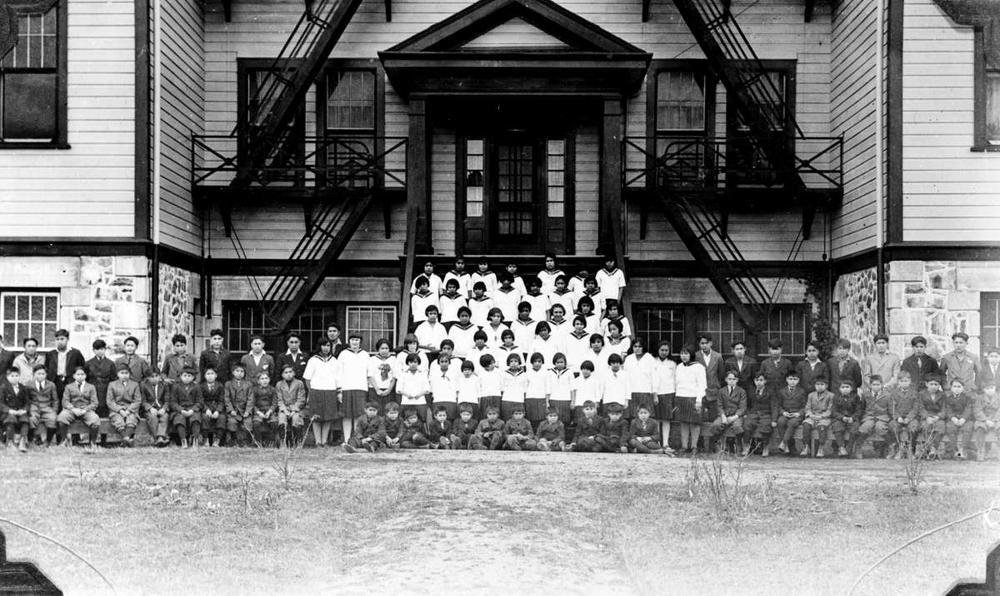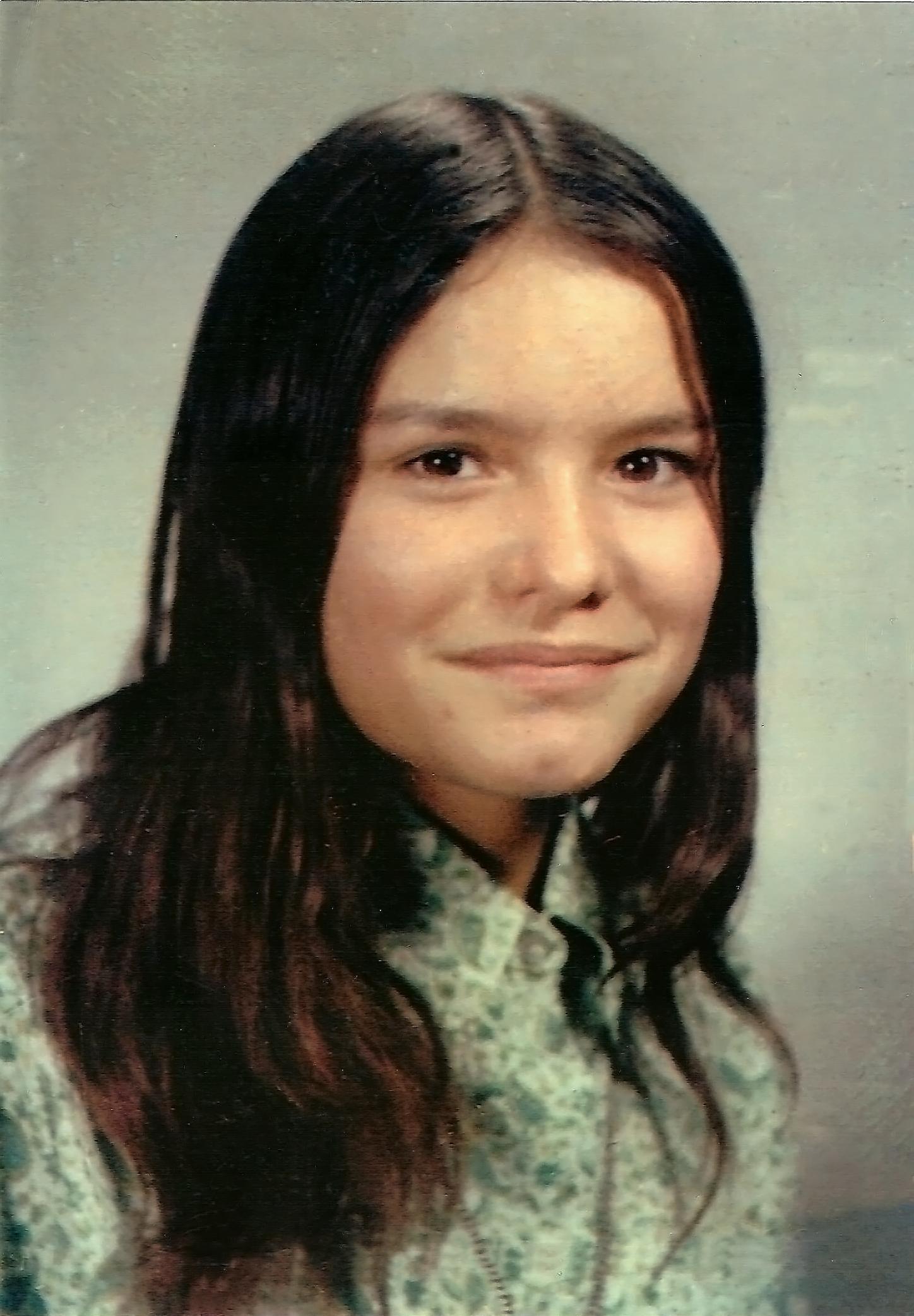Residential Schools
Canada makes residential schools official policy, setting the stage for more than a century of cultural genocide
Date: 1884
Bev Sellars doesn’t remember her first day at St. Joseph’s Residential School in the central Interior town of Williams Lake, British Columbia. But the award-winning writer and former Xat’sull chief, who was seven years old at the time, has never forgotten the piercing clap of the nun who woke her up the following morning — a startling warning of what was yet to come. From 1962 to 1967, Sellars endured physical, mental and sexual abuse, on top of other daily humiliations.
The school transformed her and her peers into “little robots,” Sellars says, fearfully obedient to the strict clergy who ran St. Joseph’s. “They always let us know that we were less than,” she recalled decades later. Instead of being addressed by her name, she was given a number. Though tragic, her experience at residential school was far from unique. Generations of Indigenous children in British Columbia and across the country were forcefully separated from their families and sent to residential schools. The aim was to erase their Indigenous identity. Abuse was commonplace.
In 1863, eight years before B.C. joined Canada, Catholic missionaries established the province’s first residential school in Mission, roughly 80 kilometres southeast of Vancouver. It wasn’t until two decades later that the federal government created a country-wide residential school system, funded by the state and administered by the church. Though a precedent existed here, Canada borrowed heavily from its southern neighbour, who had already implemented a boarding school system for Indigenous children premised on “aggressive civilization.” The Canadian government’s intentions are laid out plainly in an 1879 report by lawyer and politician Nicholas Flood Davin: “If anything is to be done with the Indian, we must catch him very young. The children must be kept constantly within the circle of civilized conditions.”
Eighteen federally-funded residential schools once operated in British Columbia, though not all with government support. Ostensibly, they were places for learning. But in reality, education appeared to matter little. Many students didn’t even progress past grade five, spending most of their time doing unpaid chores schools relied on to operate. To accomplish the government’s goal of assimilation, any reference to Indigenous culture was forbidden. Hair, which holds cultural significance for many Indigenous people, was chopped off. Speaking Indigenous languages was prohibited, even if it was the only one a child knew. To enforce these rules, staff employed violence and shame, often publicly. In some cases, nuns shoved needles into the tongues of those who dared speak their native tongue.
Besides physical and psychological torment, sexual abuse also ran rampant. In a 2005 sentencing against a former residential school staff member, B.C. Supreme Court Justice Douglas Hogarth described the schools as “nothing more than institutionalized pedophilia.” Assaults at the hands of other students were also common, prompting some children to join gangs to protect themselves. And because boys and girls were often kept separate, many couldn’t even seek the comfort of their siblings in times of trauma. Robert Joseph, a hereditary chief of the Gwawaenuk First Nation, says his interaction with his own sister didn’t extend “beyond a mere wave in the dining room.”
In 1920, the federal government made it illegal for Indigenous parents not to send children between the ages of four and 16 to residential school, a policy that remained until 1948. However, Sellars says more than a decade after residential schools ostensibly became voluntary, her grandmother still feared jail time if she didn’t send her and her siblings off to St. Joseph’s. By the 1950s, Canada had begun to recognize the detrimental effects the schools were having on Indigenous communities. As enrollment dropped, schools began to close. The last one in B.C. shuttered in 1983.
The long-term effects of residential schools have been devastating. Students left school with severe trauma that would haunt them the rest of their lives and led to high rates of substance use and suicide. With little of their childhood spent at home, many residential school survivors never experienced a nurturing family life and were sometimes left unequipped with parenting skills. Many others didn’t get a chance to come home at all. Six thousand children or more died while enrolled at residential schools, according to Canada’s Truth and Reconciliation Commission, though many believe that number is a significant undercount.
In May 2021, the Tk’emlúps te Secwépemc First Nation announced that a mass grave containing the remains of 215 children had been found near the old site of the Kamloops Indian Residential School, once the largest residential school in the country. In the weeks that followed, more First Nations across Canada announced that they had also identified unmarked graves near former residential schools. In southeastern Saskatchewan, the Cowessess First Nation found 751 graves.
The residential school system also robbed Indigenous communities of a vast amount of cultural and linguistic knowledge. Still, the government’s effort to eliminate Indigenous identity — now widely viewed as cultural genocide — failed. Thanks to the determination of First Nations, Métis and Inuit across Canada, Indigenous culture and traditions have carried on.
Sources:
1. “Christie (BC).” Indian Residential School History & Dialogue Centre, University of British Columbia, collections.irshdc.ubc.ca/index.php/Detail/entities/43.
2. Davin, N.F. Report on Industrial Schools for Indians and Half-Breeds. Canadian Adaptations of the Shakespeare Project , 14 Mar. 1879, www.canadianshakespeares.ca/multimedia/pdf/davin_report.pdf.
3. Green, Arthur, et al. “The Indian Residential School System.” British Columbia in a Global Context, Geography Open Textbook Collective, June 2014, opentextbc.ca/geography/chapter/4-4-case-study/.
4. Hanson, Erin, et al. The Residential School System. First Nations & Indigenous Studies at the University of British Columbia, indigenousfoundations.arts.ubc.ca/the_residential_school_system/.
5. Honouring the Truth, Reconciling for the Future: Summary of the Final Report of the Truth and Reconciliation Commission of Canada. Ruth and Reconciliation Commission of Canada, 2015, web-trc.ca/.
6. Hopper, Tristin. The Names of All 202 Children Known to Have Died in Vancouver Island Residential Schools. Capital Daily, 2 Oct. 2019, www.capitaldaily.ca/news/here-are-all-202-children-known-to-have-died-in-vancouver-island-residential-schools.
7. Hungry Aboriginal People Used in Bureaucrats' Experiments. CBC News/The Canadian Press, 16 July 2013, www.cbc.ca/news/canada/manitoba/hungry-aboriginal-people-used-in-bureaucrats-experiments-1.1317051.
8. The Indian Act, Residential Schools and Tuberculosis Cover Up. Indigenous Corporate Training Inc., 17 May 2016, www.ictinc.ca/blog/the-indian-act-residential-schools-and-tuberculosis-cover-up.
9. Miller, J.R. Residential Schools in Canada. The Canadian Encyclopedia, 10 Oct. 2012, www.thecanadianencyclopedia.ca/en/article/residential-schools.
10. Profile: The Life Story of Chief Bev Sellars. Talonbooks, Autumn 2013, talonbooks.com/meta-talon/profile-the-life-story-of-chief-bev-sellars.
11. Project of Heart: Illuminating the Hidden History of Residential Schools in B.C. The BC Teachers’ Federation, 2015, bctf.ca/HiddenHistory/eBook.pdf.
12. Puxley, Chinta. Up to 6,000 Children Died at Canada's Residential Schools, Report Finds. Global News/The Canadian Press, 31 May 2015, globalnews.ca/news/2027587/deaths-at-canadas-indian-residential-schools-need-more-study-commission/.
13. Residential School Locations. Truth and Reconciliation Commission of Canada (TRC), www.trc.ca/about-us/residential-school.html.
14. Residential Schools in Canada - Education Guide. Historica Canada, education.historicacanada.ca/files/32/ResidentialSchools_English.pdf.
15. Sellars, Bev. They Called Me Number One: Secrets and Survival at an Indian Residential School. Talonbooks, 2019.
16. Smith, Joanna. Canada's Residential Schools Cultural Genocide, Truth and Reconciliation Commission Says. The Toronto Star, 2 June 2015, www.thestar.com/news/canada/2015/06/02/canadas-residential-schools-cultural-genocide-truth-and-reconciliation-commission-says.html.
17. “The Kamloops Residential School’s Unmarked Graves: What We Know about the 215 Children’s Remains, and Canada’s Reaction so Far.” The Globe and Mail, 31 May 2021, https://www.theglobeandmail.com/canada/british-columbia/article-kamloops-residential-school-mass-graves-215-children-explainer/.
18. Watts, Richard. First Nation Chief Bev Sellars Recalls Growing up without Hugs. Times Colonist, 13 Sept. 2013, www.timescolonist.com/first-nation-chief-bev-sellars-recalls-growing-up-without-hugs-1.624286.




